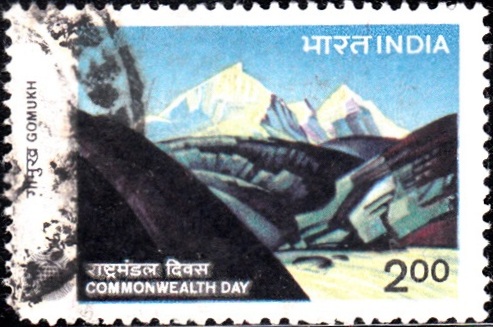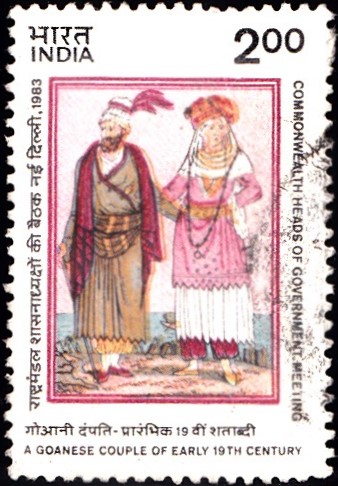
India on Commonwealth Day 1983
Complete Set of 2 nos of commemorative postage stamp on Commonwealth Day (earlier Empire Day, annual celebration of Commonwealth of Nations : Shore Temple, Mahabalipuram and Gomukh, source of Ganges river :
Issued on Mar 14, 1983
Issued for : Indian Posts and Telegraphs Department is privileged to issue a set of two stamps on the occasion.
Description of Designs : The 100p. denomination stamp depicts the Shore Temple at MAHABALIPURAM 60 kms. south of Madras in South India. The temple is poised on the shore of the Bay of Bengal with waves lapping against its base. It belongs to the earliest phase of DRAVIDIAN temple architecture and is a splendid example of PALLAVA art (c 600-750 A.D.).
The 200p. denomination stamp shows a view of GOMUKH. Gangotri glacier, in the central Himalayas, gives birth to Bhagirathi and Alaknanda rivers which join at Devaprayag to form the holy river, Ganga. The tip of Gangotri glacier from where the Bhagirathi gushes forth is known as “GOMUKH“.
Both the stamps were designed by Ram Nath Pasricha. The First Day Cover was designed by M.D. Patel and the cancellation by Charanjit Lal.
Type : Stamps, Postal Used
Colour : Multicolour
Denomination : 100 & 200 Paise
Overall Size : 4.06 X 2.73 cms.
Printing Size : 3.71 X 2.38 cms.
Perforation : 13 x 13
Paper : Unwatermarked adhesive stamp paper
Number printed : 20,00,000 each
Number per issue sheet : 40
Printing process : Photogravure
Printed at : India Security Press
About :
- The Commonwealth started as an informal organisation of the countries with large number of settlers from Britain i.e. Canada, Australia, New Zealand and South Africa. In 1926. Balfour Formula gave the first definition of the status and mutual relationship of the member countries. It stated that, “they are autonomous communities within the British Empire equal in status, in no nay subordinate one to another in any aspect of their domestic or external affairs though united by a common allegiance to the Crown and freely associated as members of the British Commonwealth of Nations“. This position was given legal formulation in the Statute of Westminster in 1931.
- India became independent in 1947 and when it decided to join the Commonwealth, the nature of the Commonwealth link changed. It was apparent that the definition in the Balfour Formula of common allegiance to the Crown could not apply to the Republic of India. India‘s joining the Commonwealth was agreed upon by the Commonwealth Prime Ministers in 1949 on the basis of India‘s “acceptance of the King as the symbol of the free association of the independent member nations and as such Head of the Commonwealth”. The term British from the British Commonwealth was also dropped.
- The Commonwealth has no constitution. However, a declaration of Commonwealth principles was made on the 27th January, 1971 after the meeting of the Commonwealth Heads of Government at Singapore. The first paragraph is worth quoting in order to establish the voluntary nature of the Commonwealth Association. “The Commonwealth of Nations is a voluntary association of independent sovereign states each responsible for its own policies of consultation and cooperation in the common interest of their peoples and in the promotion of international understanding and world peace”. Today, there are 47 members in the Commonwealth.
- The Heads of Government at their meeting in Melbourne in October, 1981, agreed in principle to the proposal of a special Commonwealth Stamp issue every five years in order to foster wider awareness of the Commonwealth and as a contribution towards the financial stability of the Commonwealth Fund for Technical Cooperation. The first issue commemorating Commonwealth Day is, therefore, taking place on 14th March, 1983.








